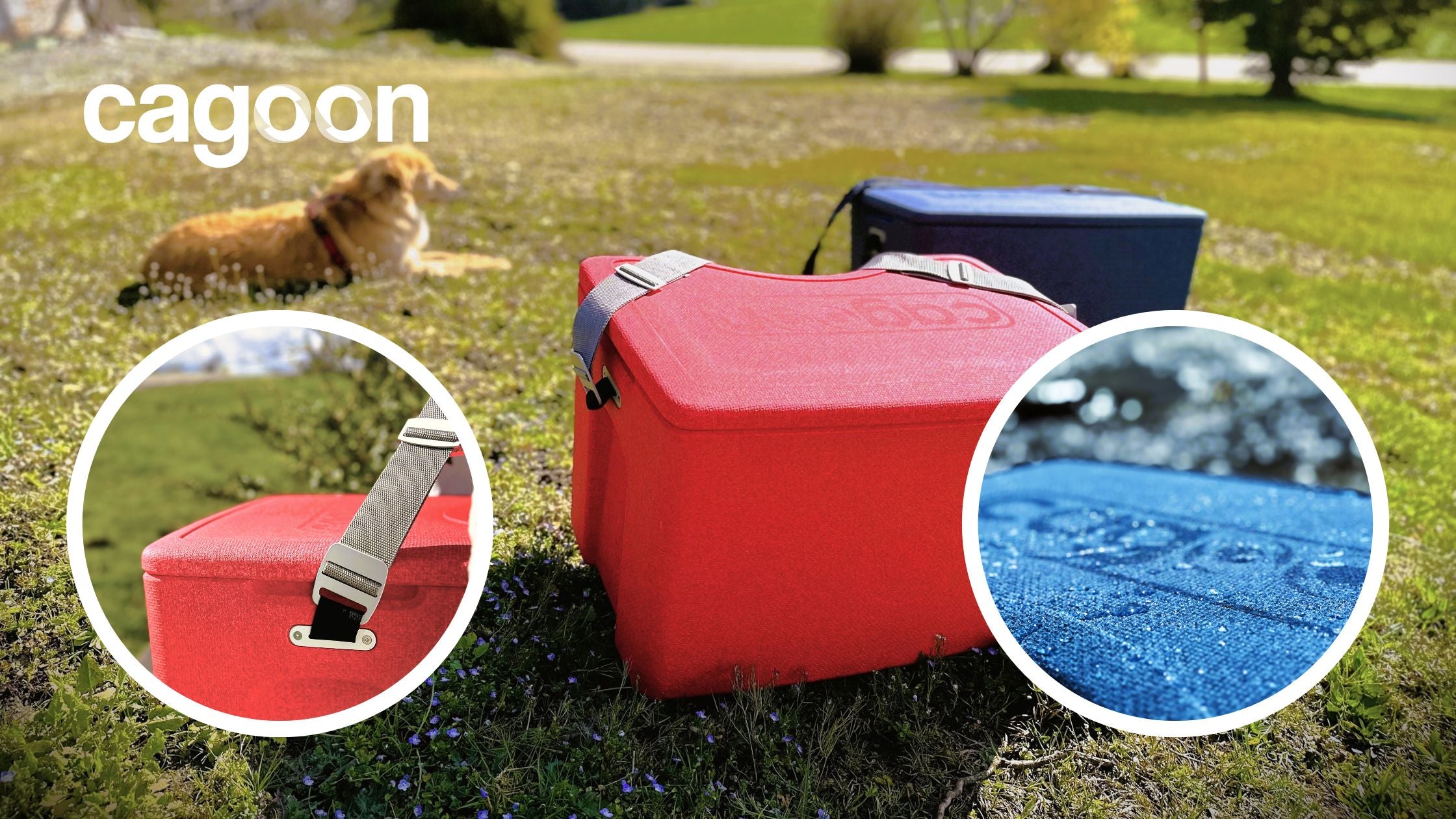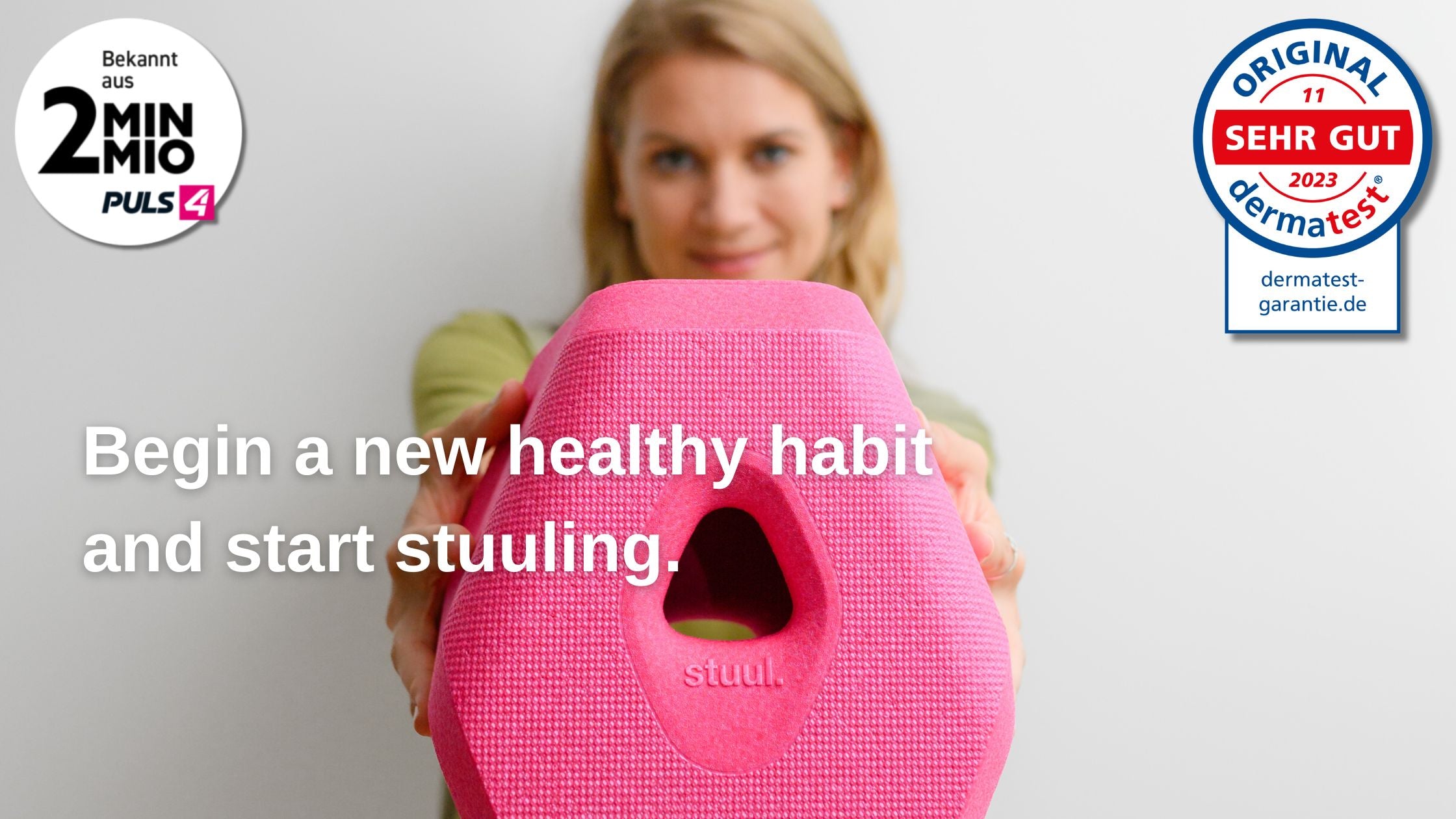In this article, we would like to take a closer look at the unique material from which our stuul toilet stool is made. It is expanded polypropylene, or EPP for short, a real high-tech material with unique properties that is also used to make other well-known consumer products from Germany, such as the fascia roll from Blackroll or the play elements from Stapelstein. To find out more about the properties of this high-tech material, our founder Daniel talks to Johannes Ebert, founder of the company CAGOON, which has chosen the same material for its insulating multifunctional box AEROSTUFFY.
Daniel:
Hello Johannes, I'm delighted to welcome you to our toilet stool blog. We are not only connected by the fact that we were both so enthusiastic about a product idea that we absolutely wanted to realize it, but also by the fact that we chose the same "raw material" for our products on this journey. It would be best if you could briefly introduce yourself and your company to our readers. Please describe briefly how you came up with the idea and why you chose EPP.
Johannes:
Hello Daniel, I am delighted to have been invited to this interview and look forward to an interesting exchange about the high quality EPP material that we both appreciate so much.
CAGOON is a young brand from Rosenheim that offers unique outdoor products with a minimal ecological footprint that are 100% Made in Germany. Our products are highly practical, extremely durable and of high quality - perfect for an active lifestyle.
For our first product, the AEROSTUFFY multifunctional box, we chose EPP as the main material because it is insulating, robust, lightweight and recyclable. In contrast to your toilet stools, the AEROSTUFFY multifunctional box is not only made of EPP, but also of other high-quality materials such as polyamide and aluminum to ensure a variety of carrying options and functions. During product development, we placed great emphasis on ensuring that all individual materials can be efficiently recycled at the end of the product life cycle.
EPP has outstanding material properties and makes the AEROSTUFFY approx. 70 % lighter and at the same time more stable than comparable passive coolers. Unlike conventional plastic boxes made of PP, which often cannot be repaired, the AEROSTUFFY made of EPP can be glued back together after breakage.
In collaboration with the Technical University of Rosenheim, we tested the stability of the box and found that the AEROSTUFFY can withstand a load of 942 kg. Even after repairing the previously tested box, it was still able to withstand over 700 kg.
In summary, EPP is the first choice when it comes to aesthetically pleasing products that are lightweight, robust and recyclable.
Daniel:
It is impressive to hear how stable the AEROSTUFFY is under load. The combination of stability and lightness also played a central role in the choice of material for our toilet stool.
But let's take one step back. Can you tell us again how you came up with the idea of developing a new type of multifunctional box in the first place?
Johannes:
You're welcome, Daniel. The idea was born a few years ago at the " lovely" recycling center. A recycling center is a typical German thing - disposing of a lot of waste with a clear conscience. If you spend some time there and see the vast quantities of plastic boxes, tubs, folding boxes and the like that are disposed of there, you inevitably start to wonder.
Many of these plastic products have only had a short, undamaged life, cannot be repaired and therefore end up in bulky waste. From there, they are usually sent for thermal recycling in waste incineration plants. There are many reasons for the short service life. In most cases, it is a combination of unsuitable material and poor construction. So it's no wonder that every citizen produces an average of 37 kg of bulky waste per year.
The sight of so many broken plastic boxes was the impetus behind the CAGOON project and the multifunctional boxes. We wanted to develop products that are versatile, durable and repairable and can be fully recycled at the end of their life. The AEROSTUFFY boxes should see every corner of this beautiful earth, just not the inside of a bulky waste container.
It's great that there are so many parallels with the Stuul toilet stool!
Daniel:
There are indeed very clear parallels to the story of how our toilet stool was developed. When choosing the material, it was also very important to me to be as environmentally friendly as possible. What particularly fascinated me about EPP was that it consists of well over 90 percent air and is still so stable. Of course, this saves a lot of material right from the start. At the end of its life cycle, it is also 100 percent recyclable, i.e. if you throw one of our toilet stools into the shredder, you can produce a new one from the shredded material. This is unique among plastics.
We should actually join forces with our colleagues from Blackroll and Stapelstein, but also with the automotive industry as the main consumer of EPP, and set up a cradle-to-cradle recycling system for EPP. As far as I know, there is no such thing yet, is there? How realistic would that be from your point of view?
Johannes:
Our high-tech material is probably the plastic with the best recycling properties. New EPP products can be made from EPP toilet stools or CAGOON extreme boxes. This advantage over polystyrene (EPS) or ABS, for example, was a key point for me during product development. By the way, the automotive industry has already established efficient recycling systems for EPP that we can build on. However, the recycling processes still need to be refined before the recyclate obtained can be used 1:1 for a new product.
But above all, we need the help of our valued customers. At CAGOON, we always say: "We want to come into contact with our customers at least twice in a lifetime - when they buy and when they return the product at the end of its life." This is where another highlight of EPP comes into play: it can be cut up easily with a carpet knife and thus reduced to a small volume - ideal for shipping to us or for disposal in EPP containers. There are already a number of EPP collection points in Germany.
Daniel:
That is very interesting. I definitely need to take a closer look at the existing take-back options for EPP. Something completely different: how important are skin-friendliness and hygiene for you and your multifunctional box? These material properties naturally play a very important role for our toilet stools.
Johannes:
You raise a very important point. We kept fruit and vegetables in our CAGOON AEROSTUFFY on the balcony throughout the mild winter. Whether frost, sun, snow or rain - the food was always fresh and well protected. Without exception, the boxes are suitable for contact with food. However, we once forgot to use a multifunctional box for a few weeks and the vegetables started to get moldy. Not a pretty sight, but no drama - with a metal sponge and cleaning products, we were able to clean everything again in no time at all. Thanks to the extremely robust surface, you don't have to be squeamish when cleaning either.
Daniel, can I ask you a question? If the toilet stool increases your well-being and makes you feel better, does it also give you better ideas in the restroom? Have your customers already told you about a brilliant idea with the toilet stool?
Daniel:
I've already received a lot of positive feedback from customers, but that wasn't one of them. But you're right: using a toilet stool does change your bowel habits a lot. On the one hand, bowel movements are more pleasant because you don't have to push and squeeze as much, and on the other hand, it's much shorter because it's quicker overall. So you spend less time on the toilet, and since most people nowadays are on their cell phones, we reduce this pointless screen time. So our customers don't necessarily get better ideas, but time - that's something.
I have one last question regarding the material:
I have seen that you offer your CAGOON AEROSTUFFY in black, silver and red. One color variant particularly appeals to me personally. We call it Ocean and it's a beautiful turquoise. But what I like even more than the color is the story behind this variant. A large proportion of the plastic from which it was made comes from waste from sea fishing, such as old nets or boxes that were collected from the fishing industry. The whole thing is an initiative by the company Plastix, which aims to combat marine pollution. What do you think of this and are you planning to offer your boxes made from this material too?
Johannes:
This is a really innovative and useful solution for making high-quality products from discarded fishing nets. The color is also exciting and reminds us of the origin of the material. We would like to use it, but at the moment we are not allowed to. The background is this:
The stuul toilet stool and the CAGOON AEROSTUFFY are virtually at opposite ends of the food chain - we take care of perfect solutions for the transportation and storage of fresh food, and you take care of the "big" end. As our boxes are in direct contact with the food, we at CAGOON have to take great care to ensure that the materials we use are approved for food contact. Unfortunately, this is not yet the case for the Ocean color. Once approval is granted, an AEROSTUFFY Ocean will soon be a reality. By the way: our BOXES float on water 🙂 .
But you raise an important point: We as developers, product enthusiasts and manufacturers should always strive to reduce resource consumption bit by bit according to the "reduce, reuse, recycle" principle.
Daniel:
I totally agree with you! I'm delighted to have such a close comrade-in-arms with you and look forward to continuing our exchange. Of course, I wish you continued success with your AEROSTUFFY boxes, which I can only recommend to everyone.
JOHANNES EBERT & CAGOON

























































































